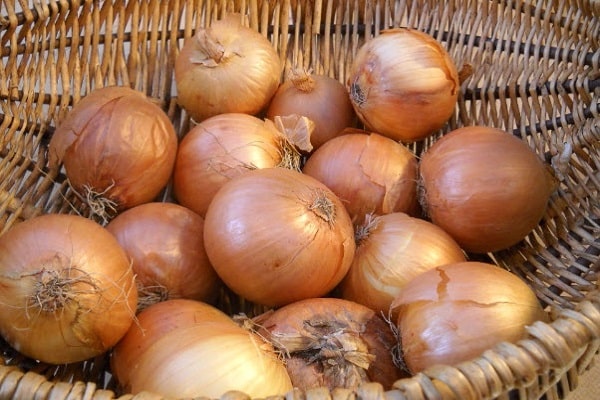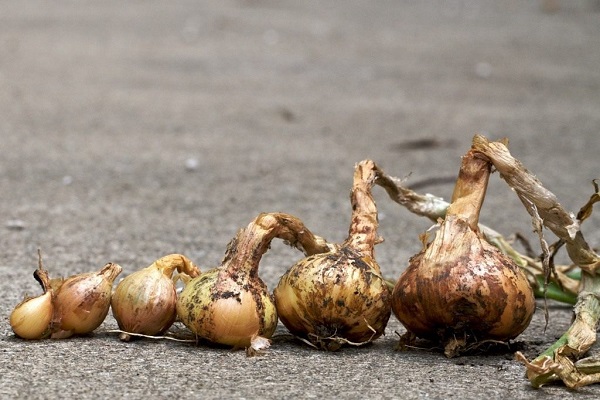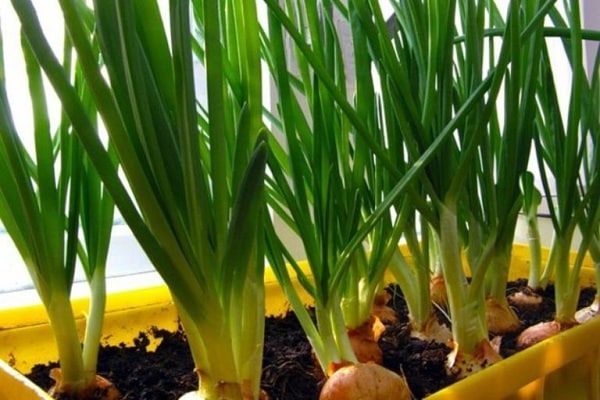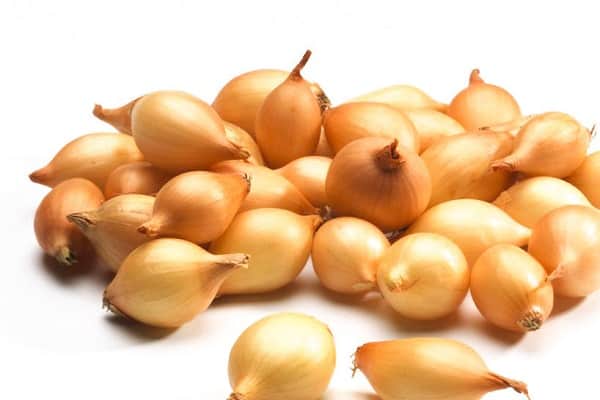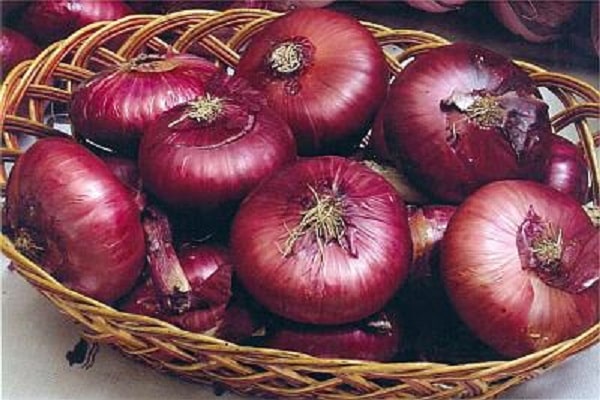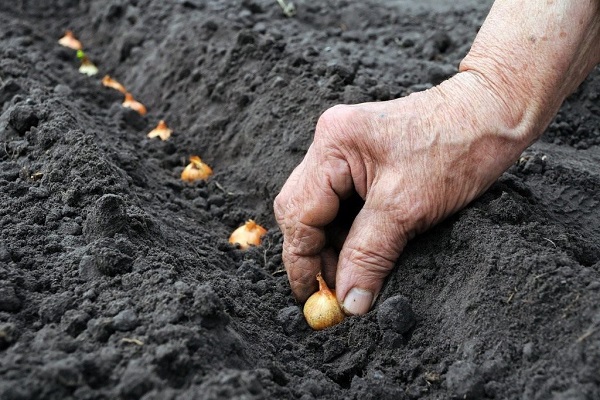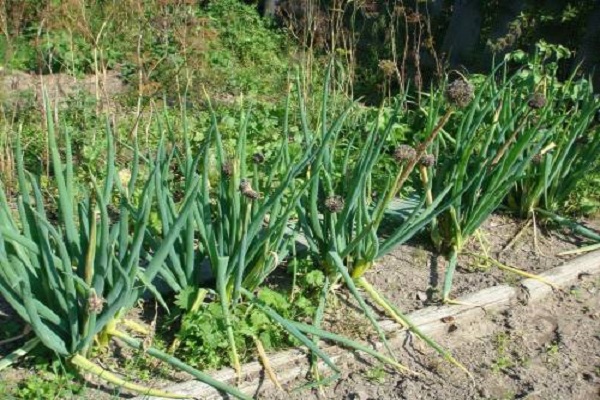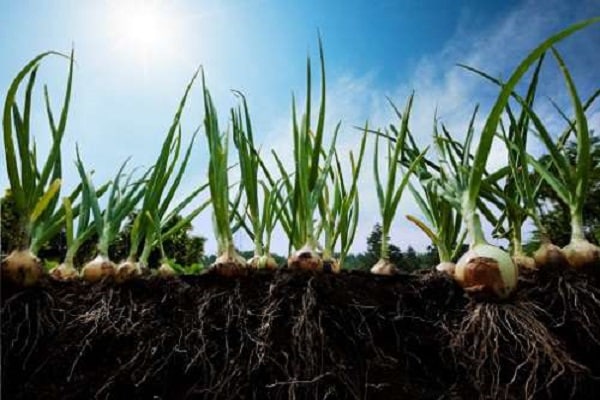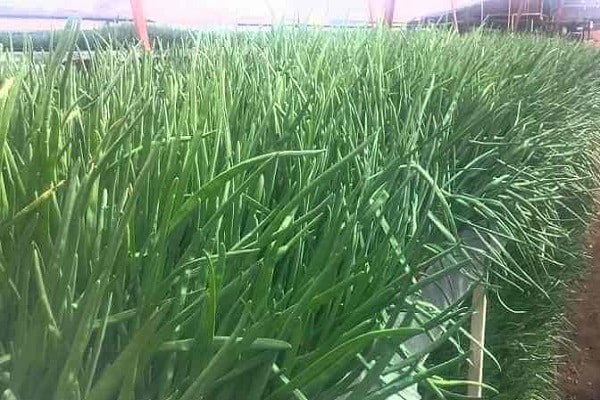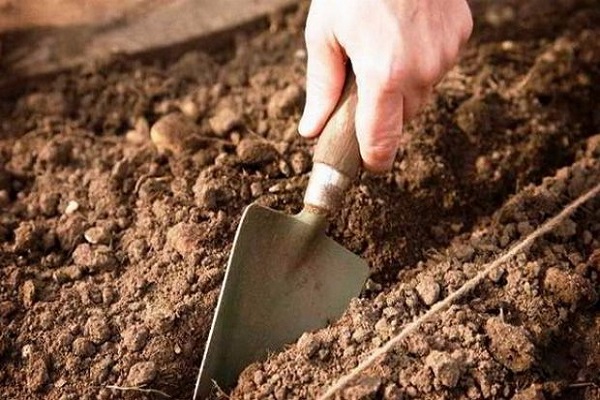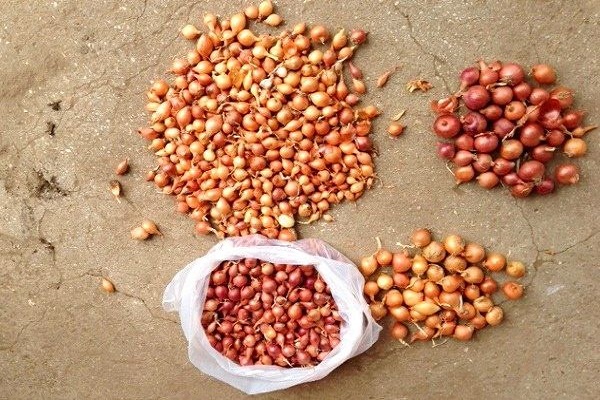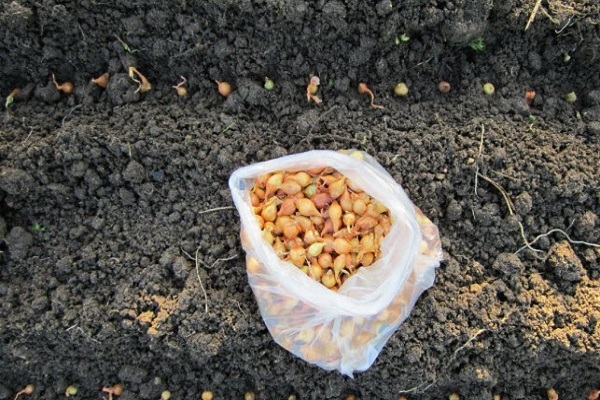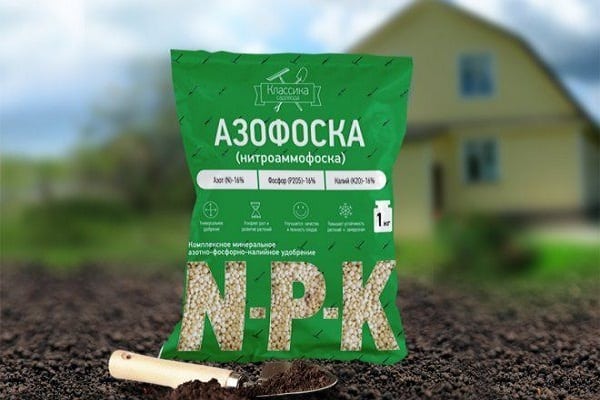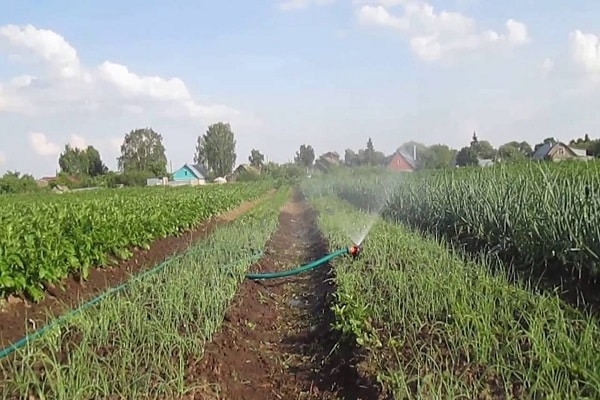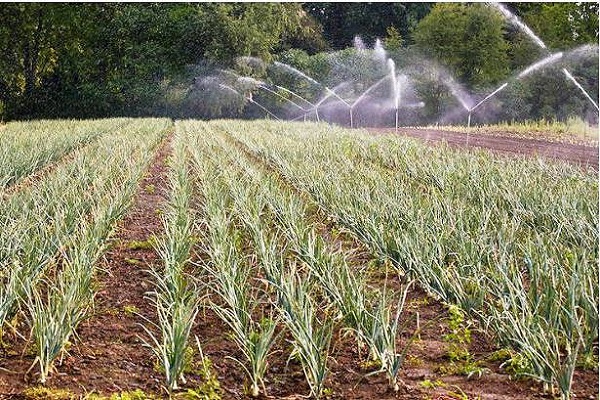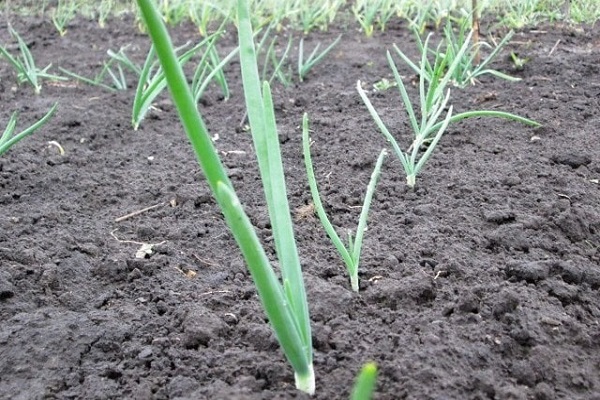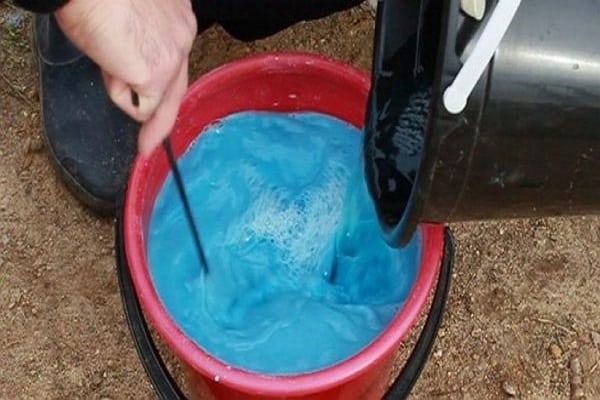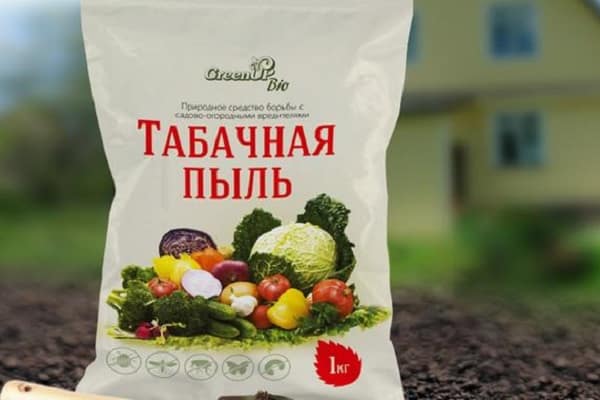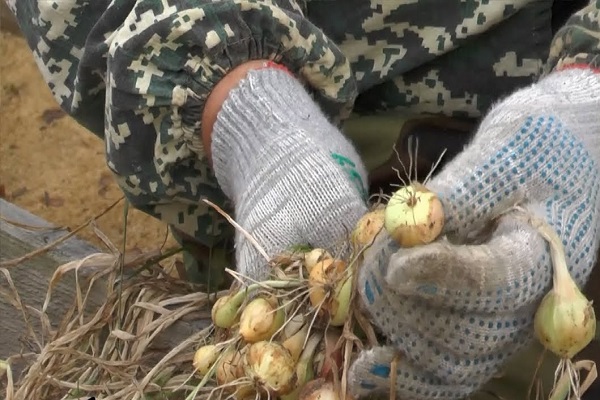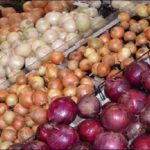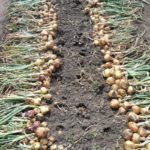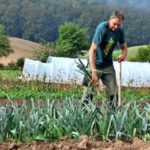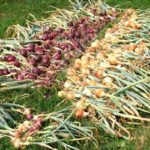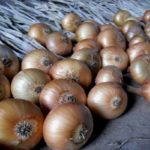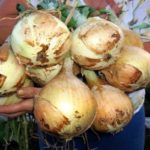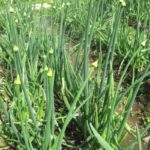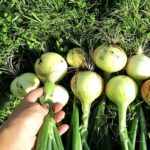Onion cultivation must be carried out according to certain agrotechnical rules. This will allow you to harvest a rich and high-quality harvest.
- Biological features of onions
- Variety of onions
- Onions are divided into groups based on taste
- General approaches to agricultural technology for growing onions
- Predecessors and compatibility
- Soil requirements
- Environment Requirement
- Specifics of growing onion from sets
- Preparing the soil for sowing
- Preparing the sets
- Planting sets
- Feeding
- Watering
- Loosening, thinning
- Protection from diseases and pests
- Harvest
Biological features of onions
Bulb onions belongs to the lily (onion) family and the monocot class. Central Asia is considered its homeland.This vegetable crop is grown in almost all garden plots. Spicy heads are used as a seasoning and added to many dishes.
Onions are rich in useful substances. The taste and smell are due to the high content of essential oils. Their content may vary, it all depends on the growing conditions, the degree of maturity and storage of the harvested crop. Knowing the secrets of onion care and cultivation, you can get a healthy, rich and high-quality harvest.
There are more than 400 types of onions, but only 10 of them have been introduced into cultivation. The vegetable belongs to the one, two and three year group of plants. When sowing seeds (nigella), a set is obtained. The seeds are small, weighing only about 1 g, the set reaches 2 cm in diameter. When planting the set, large onion heads are obtained. When they are planted in the third year, they again receive arrows with boxes in which the seeds ripen.
Onions are a cold-resistant crop. Seeds germinate at temperatures around +3 degrees. However, growth and development occur best at an air temperature of +11 degrees.
The root system of onions is poorly developed, so it places great demands on the composition of the soil. In addition, during cultivation, onions require special care.
Variety of onions
There are two large groups of onions intended for cultivation in open ground:
- A group of varieties for northern regions, where daylight hours are about 16 hours. Only with such a long day will large bulbs form and seeds develop. Northern varieties with short daylight hours will only have time to form green feathers.
- Southern varieties of onions can form large, dense and juicy onions with short daylight hours (day length is about 12 hours).If you plant such varieties in regions with long daylight hours, the bulb will form and store poorly.
Currently, breeders are developing varieties that do not respond to daylength. When planting them in both northern and southern regions, you can get a good harvest.
Before sowing in open ground, it is recommended to treat planting material of any variety with growth stimulants and disinfectant solutions.
Onions are divided into groups based on taste
Exist types of onions, which can be divided according to taste. It all depends on the ratio of sugar and essential oils in the onion:
- Spicy.
- Peninsular.
- Sweet (salad).
If the sugar content of this cultivated plant is low, then the level of essential oils is low. Such an onion will not be very sharp and few green feathers will form. In addition, the taste is affected by proper care and taking into account all the rules of agricultural technology. Breeders annually develop new types of onions for cultivation. Among the new varieties, there are those that have a sweet taste without a hint of bitterness.
Sevok is planted very early in the spring (late April or early May) or as seedlings. Nigella seedlings begin to be sown in mid- or early February. After just two months, the seedlings will be ready to be transplanted to a permanent location. In order for the crop to receive all the necessary nutrients, it must be properly cared for.
General approaches to agricultural technology for growing onions
If all agrotechnical practices are followed, you can grow a good harvest of onions in the basement. For this purpose, special wooden shelves with lighting are made. Place polyethylene film on the bottom of the structure and fill it with soil. In the future, the growing technology is no different from caring for outdoor beds.
Predecessors and compatibility
The reason why onions do not grow in the garden is sometimes the wrong place for planting.
The best precursors for onions are vegetables such as cabbage, cucumbers, tomatoes, potatoes, zucchini, and legumes.
Next to the onion beds you can plant carrots, cabbage, beets, radishes, herbs (dill, parsley, cilantro).
Soil requirements
In order for onion heads to grow large in the garden, the soil must meet certain requirements:
- The soil in the beds should be moist, especially in the first weeks after planting. But overmoistening should not be allowed, as this leads to a decrease in taste, rotting and a reduction in the shelf life of the crop.
- There should be neutral acidity. If the acidity is high, it is recommended to add wood ash.
- To grow giant onions, the soil must contain plenty of nutrients, especially organic matter. Even in the fall, compost or humus is added to the soil at the rate of 5–6 kg per 1 square meter. m.
Onions grow well in loose, loamy, sandy loam or chernozem soil, which is characterized by high moisture capacity and moisture permeability. If the soil is heavy and acidic, the harvest will be poor.
Environment Requirement
Another unfavorable factor why onion bulbs do not grow is bad weather conditions. Onions are a cold-resistant crop, so they can be planted in early May, when the air temperature is around +5 degrees. The soil temperature should not be below +10 degrees.
Cooling affects the speed of development and growth of the plant. The onion heads grow small, the plant has poor immunity, and the harvested crop will not be stored well.
Specifics of growing onion from sets
Large heads are obtained by growing onions using the Chinese method. Seed material is planted on high ground - ridges that are prepared in advance. The bulbs are deepened by 3 cm and sprinkled with a small layer of earth.
Preparing the soil for sowing
The soil for planting seedlings begins to be prepared in the fall. It is recommended to dig the area deeply (to a depth of 25 cm), and at the same time apply potassium-phosphorus fertilizers. When treating the soil in autumn, the ability to absorb moisture increases. If the soil is highly acidic, it is recommended to add wood ash, dolomite flour or ground chalk in the fall.
Do not dig the soil too deeply in the spring, as the loose substrate prevents seed germination. It is better to loosen the area slightly with a rake in the spring and apply nitroammophoska.
How many days onions grow depends on the variety. On average, a vegetable needs 2.5–3 months to grow. They plant it in May and start digging it in August. Even if the onion head has not grown large enough, you should not keep it in the ground after ripening. As soon as the feathers turn yellow, dry and fall to the ground, start digging.
Preparing the sets
If sets of any varieties of onions were purchased in a store, then they need to be dried by spreading them in one layer on cardboard or fabric material away from heating appliances. If the seedlings were grown independently, then before planting they need to be warmed thoroughly to activate growth. It needs to be heated for two weeks at a temperature of +20 degrees, then heated for 8–10 hours at a temperature of +35 degrees.
Before planting, you can simply fill the seedlings with hot water for 15–20 minutes (the water temperature should be about 45 degrees). After this, the seedlings are transferred to cold water.
After the warming procedure, it is useful to place the planting material in solutions that stimulate growth.For this purpose, drugs such as Zircon, Rost, and Humisol are used.
Onion seeds Disinfected before planting in open ground. For this purpose, it is placed in a weak solution of potassium permanganate or in a solution with copper sulfate (5 g of copper sulfate is taken per 10 liters).
Planting sets
It is best to plant seedlings in mid-May, when the weather is consistently warm. The soil should warm up to +12 degrees. The best place for planting is an elevated place where groundwater does not flow. The site should receive sunlight all day without any obstacles.
In the selected area, furrows are made at a distance of 15–18 cm, 3 cm deep. After this, the furrows are watered with warm water and the seedlings are planted at intervals of approximately 8–10 cm. Do not deepen the seedlings too much; cover it with a small layer of earth on top.
After planting, the seedlings need special care. You need to water twice a week, do not allow the spread of weeds, and after two weeks you need to carry out the first fertilizing.
Feeding
Proper care of onions in open ground consists of timely application of fertilizers:
- The first feeding is carried out 15–17 days after planting, when the active growth phase of greenery begins. If the feather grows weak, thin and pale, then micronutrients can be added earlier. They use a urea-based solution, which is poured under the root, nitroammophoska. A liquid solution of mullein is suitable as the first feeding.
- The next application of fertilizer is carried out in mid-June, three weeks after the first feeding. At this time, the underground part of the plant is actively developing and it is important to add potassium-phosphorus compounds. You can prepare a solution of superphosphate and potassium salt.
- The third fertilizing with potassium-phosphorus fertilizers (without nitrogen) is carried out only if the soil is depleted and the plants themselves look weak and develop poorly.
If organic matter was added in the fall and all plant residues were removed from the site, then this is usually enough to obtain a good harvest.
Watering
Another thing to consider when growing onions is that they like moist soil. In the first month after onions sprout, you need to water them once every two weeks. If the weather is dry and hot, then the number of waterings increases to once a week.
Water for irrigation must be warm and it is better to pour it between rows. It is advisable to carry out the procedure in the evening or early in the morning.
Loosening the soil is carried out after watering. This procedure allows you to destroy pests and their larvae, prevent the formation of crusts and allow oxygen and nutrients to quickly penetrate the roots of the plant.
After watering, the soil should be wet to a depth of 10 cm. During the period of bulb formation, the abundance of watering increases.
Two weeks before the expected harvest, watering is stopped, only dry loosening is carried out. This will allow all the nutrients to accumulate in the head and not form a crust on the surface of the soil.
Loosening, thinning
As the onions grow, thinning is carried out. When planting densely, two thinnings are carried out. The weakest and smallest plants are removed. During the first thinning, a distance of 4 cm is left between the plants. The second thinning is carried out a month later, leaving a distance of 8 cm between the onions.
Loosening is carried out after watering the soil and after rains.This procedure prevents the spread of weeds and allows oxygen to penetrate unimpeded to the roots.
Whether it is necessary to rake the soil away from the bulbs is a decision that each vegetable grower makes independently. But it has been noticed that the procedure makes it possible to advance the ripening period faster, since more light and heat penetrates to the bulb. The soil should be raked a couple of weeks before harvest.
Protection from diseases and pests
Vegetable beds are often attacked by insect pests and various infections. To reduce the risk of these misfortunes, preventive treatments are carried out on onion beds. Both folk formulations and ready-made, store-bought preparations can be used.
For preventive purposes, onions can be treated with a solution based on copper sulfate. Dissolve 5 g of this component in 10 liters of water and add 30 ml of liquid soap.
Wood ash, ground pepper, tobacco dust. The mixture of these components is sprinkled between the onion rows. Between the rows, the soil can be watered with a saline solution (200 g of table salt diluted in 10 liters of water).
Loosening helps destroy pest larvae. You need to loosen onions as often as possible, especially after watering or after rain.
Harvest
Harvesting begins after a third of the onion leaves turn yellow, dry out and fall to the ground. At the same time, the neck of the bulb becomes soft, thins and dries.
After digging, the crop can be dried directly in the garden. If the weather is rainy, then the onions are put indoors. It takes about two weeks for the bulbs to dry completely.
For storage of onion harvest It is better to choose a cool, dry, dark room with good ventilation. The air temperature should be approximately +3 degrees.


